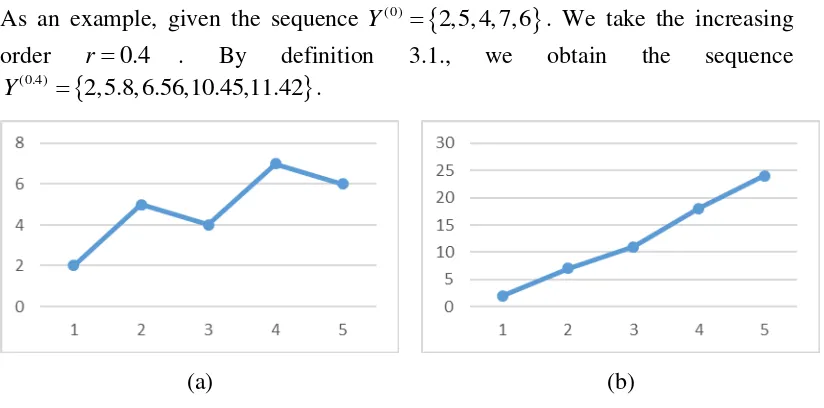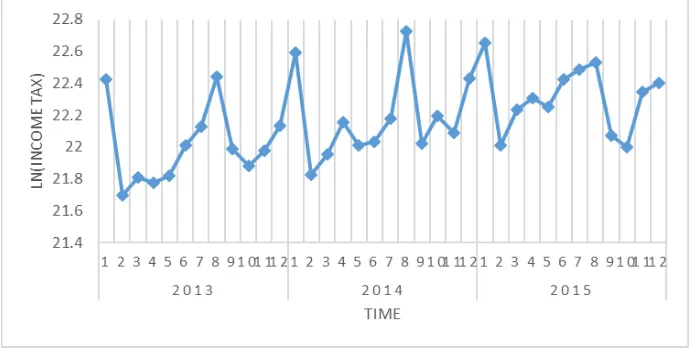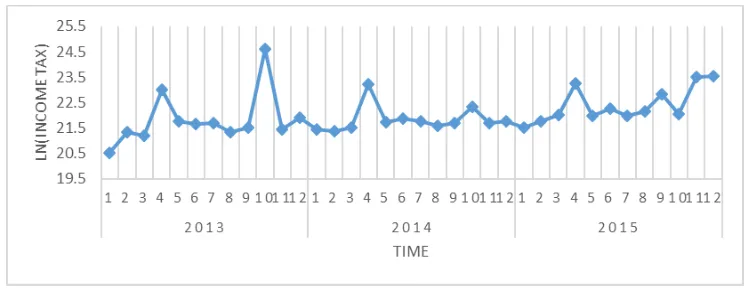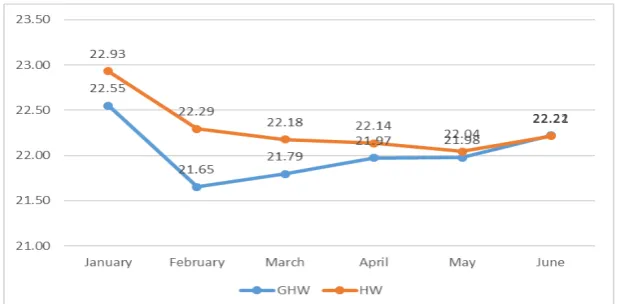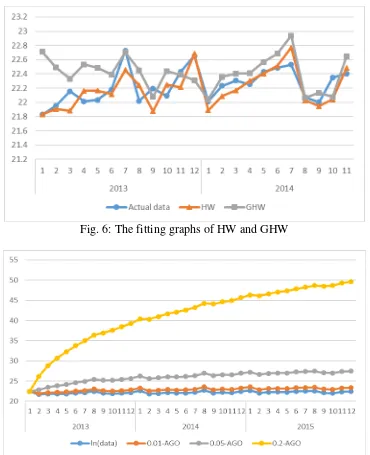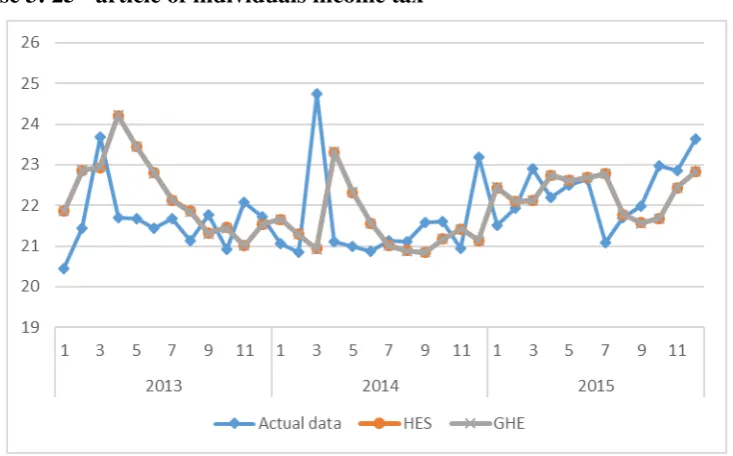Int. J. Advance Soft Compu. Appl, Vol. 9, No. 1, March 2017 ISSN 2074-8523
Grey Exponential Smoothing for Forecasting
Indonesian Income Tax
Arum Handini Primandari1, Tuti Purwaningsih1, Randi Putra Oetama1
1Islamic University of Indonesia,
e-mail: primandari.arum@uii.ac.id, tuti.purwaningsih@uii.ac.id, randiputraoetama@gmail.com
Abstract
Income tax is one of Indonesian financing sources to fund its expenditure. It is used to defray national development for improving public welfare. Therefore, the government sets the target for tax revenue so that it can be managed effectively. Predicting the target would help the government to thoroughly prepare the tax management. Because of either trend or seasonal pattern on its data, the basic method commonly used is holt-winter exponential smoothing. However, due to various schedule of tax payment, data have random shock. We employed grey method which was applied on exponential smoothing to reduce this random, hence we have smoothed data. In optimizing the parameters of the exponential smoothing, we used levenberg-marquardt algorithm. The result shows us that grey-holt exponential smoothing method is not always outperforming basic holt-winter exponential smoothing for forecasting Indonesian income tax.
Keywords: forecasting, exponential smoothing, levenberg-marquardt, income tax.
1 Introduction
As it is already known that tax is an obligatory contribution to state imposed upon both individuals and legal entity. Taxation is regulated by law and is used to fund the government. The money provided by taxation has been used to defray national development, such as roads, health, education, public services, etc.
Arum Handini Primandari et al. 89
The income tax data we used have both slight trend and seasonal pattern. It can be seen from its graphics. Moreover, there are some shocks in the specific data due to payment schedule.
Holt exponential smoothing (HES) has high accuracy prediction on the data with trend. While holt-winter exponential smoothing (HW) works well on both seasonal and trend data. Over the time, there are a lot of researches on exponential smoothing to improve its ability in forecasting [3][4].
Since it seems that there are more series which have multiplicative trend than additive trend, some researches tend to develop this scope. The parameter to dampening the multiplicative trend added to exponential smoothing improves the forecast accuracy [2][6]. Furthermore, to deal with the random interference on data, grey method generates an operator to smooth it. It has been proved that applying grey method on double exponential smoothing could outperform the traditional one [7].
In this research, we apply grey method on both HES and HW for forecasting the income tax. The Levenberg-Marquardt optimization is used to optimize the parameters on those exponential smoothing. By comparing the Mean Squared Error (MSE), we gain the best method to predict Indonesian income tax.
2 Problem Formulations
Since the payment of tax is already scheduled, the tax revenue will be significantly increased on the due date. However, because of some reasons, the revenue will be unpredictable. These patterns are the characteristic of Indonesian income tax.
The traditional exponential smoothing with double smoothing parameters is suitable to predict the data with trend which either has multiplicative or additive trend. The optimal value of parameters will give us the best forecasting since it minimizes error. Beside the parameters itself, prediction accuracy depends on how we take the initial value.
Data with random interference need a specific treatment. The sudden move which is happened on the data sometimes causes a problem. Therefore, we need to handle this problem first.
In the tax data which have both seasonal and trend pattern, we employ a method named HW. However, because of the random trend which is occurred in some data, apart from the peak of the seasonal data, we also need another method that can solve this problem.
One of the methods which provide an operator that can smooth the random interference is grey method. We apply this method on exponential smoothing method so it can elevate the precision of forecasting.
90 Grey Exponential Smoothing for Forecasting
3
Method
3.1
Grey Exponential Smoothing
HES is method for handling linear trend. The most prominent advantage of this method is to vary the deterministic trend on time series data [3]. It has two basic smoothing formulas for level term and growth term, which are
Level : t yt
1
t1bt1
formula of multiplicative HW method is expressed as:Level :
1
1 1
Where m is the length of seasonality (e.g. the number of months or quarters in a year).
Define 3.1 [7] For the original time series Y(0)
y(0)(1),y(0)(2),...,y(0)( )n
, an r-order accumulated generating operator (AGO) sequence
Arum Handini Primandari et al. 91
The inverse of r-order of AGO is called inverse accumulated generating operator (IAGO). When we take 0<r<1, the r-order of IAGO of Y( )r is expressed as
Fig. 1: (a) The original sequence; (b) The sequence by 0.4-AGO
The process of calculating grey method on exponential smoothing is defined as follow:
Step 1 : Set the number of r and obtain the r-AGO sequence using equation (3).
Step 2 : Calculate the optimal parameter for exponential smoothing.
Step 3 : Compute the predictive value using equation (1) or (2).
Step 4 : Transform the prediction value to the original sequence by means of IAGO using equation (4)
3.2
Levenberg-Marquardt
In order to fitting a function y t pˆ
; of an independent variable t and a vector of nparameters p to set of m data points
t yi, i
, it is convenient to minimize the weighted squared of residual [1]. The residual define as follows:92 Grey Exponential Smoothing for Forecasting
where the value of w is a measure of the error in measurement y t
i . Theweighting matrix W is diagonal with Wii 1 wi2.
The Levenberg-Marquardt algorithm parameter updates define as follows [1]:
ˆ
T T T
lm
J WJ diag J WJ h J W y y
,
where h is the parameter update, J is the jacobian matrix
yˆ p
.3 Numerical Result
Income tax is one of the most contributing taxes to tax revenue levied by General of Taxation Directorate of Indonesia. There are several kinds of income taxes; the top three income taxes which give the greatest contribution are 21st article of income tax, 25th article of corporate income tax, 25th article of individual income tax. The assessable incomes include salaries, honoraria, allowances, and other payments. While taxpayers have more than earning source, they pay installment written on article 25.
The data are monthly income tax from 2013 to 2015. Since monthly data in 2016 has not been published, the recent data we could manage to obtain is data in December 2015. We transformed the data using ln to shrink the scale because the unit data amount is in billion.
Fig. 2: The ln transformed of 21st article income tax
Arum Handini Primandari et al. 93
Fig. 3: The ln transformed of 25th article corporate income tax
The data in Fig. 3. has different highest peak in every year. We did not acknowledge it to has seasonal pattern. Althogh in 2013 and 2014 the spike occurred at fourth and tenth, but in 2012 it did not.
Fig. 4: The ln transformed of 25th article of individuals income tax
Comparing to others income tax data, the 25th article individual income tax is less random. It only has a slight trend, both upward and downward.
3.1 Analysis Result
We made comparison of grey method applied in exponential smoothing and basic exponential smoothing. There are three cases according to the data.
Case 1: 21st article income tax
Take the series in Fig.1., we analyze it using both HW and GHW with levenberg-marquardt optimization. We used r = 0.01 as increasing factor to GHW. The result is showed in Table 1.
Table 1: The result of 21st article income tax
Method α β γ MSE
94 Grey Exponential Smoothing for Forecasting
GHW 0.99575795 2.55E-14 0.184287 0.108152
Case 2: 25th article corporate income tax
We worked both HES and GHE to data in Fig. 2. Since it showed low growth, we used r = 0.001 to GHE. The result is presented bellow.
Table 2: The result of 25th article corporate income tax
Method α β MSE
HES 0.2875 0.5565 0.914669
GHE 0.2924 0.5538 0.888442
Case 3: 25th article of individuals income tax
In the third case, we take r = 0.0011 as the consequence of slight increment. The result of HES and GHE are presented in Table 3.
Table 3: The result of 25th article of individuals income tax
Method α β MSE simultaneously result of Table 1., Table 2., and Table 3.
Table 4: The fitted values 21st article income tax
Actual data HW GHW
August 22.528 22.771 22.938 September 22.071 22.025 22.063 October 22.002 21.945 22.134 November 22.347 22.041 22.074 December 22.403 22.483 22.644
Table 5: The fitted values 25th article corporate income tax Actual data HES GHE
August 22.148 22.449 22.434 September 22.821 22.370 22.352 October 22.039 22.573 22.566 November 23.499 22.417 22.405 December 23.556 22.286 22.894
Arum Handini Primandari et al. 95
August 21.692 21.779 21.771 September 21.986 21.575 21.566 October 22.972 21.686 21.679 November 22.867 22.438 22.438 December 23.638 22.826 22.830
Using exp() to transforming back, we would have the original data. For example, the forecasting of December 2015 of 21st article income tax is IDR 5,812,635,968
by HW. The graphs of the three cases fitted values are presented in the appendix.
Fig. 5: The Forecasting values of 21st article income tax
The forecasting value of 21st article income tax can be seen in Fig. 5. According
to Fig. 5., traditional HW always have higher value of forecasting than GHW. This is a good sign because Holt-Winter method always encounter overforcast [7].
4 Conclusion
If 0<r<1, then r becomes increasing order to smooth linear trend. It provides more weight to the recent changes. However, not all cases have the same result which is GHES outperforms HES method. Even though employs r as the increasing order, in some cases it does not significantly improve the accuracy of prediction. Moreover, applying grey method on both holt and holt-winter exponential smoothing does not always show more precise forecasting.
5 Open Problem
96 Grey Exponential Smoothing for Forecasting
ACKNOWLEDGEMENTS.
Academic Development Directorate of Islamic University of Indonesia (BPA UII) for funding the conference.
References
[1] Gavin, Henri P. 2015. The Levenberg-Marquardt Method for Nonlinier Least Square Curve-Fitting Problems. Structural Dynamics and the Seismic
Response Control Laboratory: Experimental System. September 29. Accessed June 9, 2016. http://people.duke.edu/~hpgavin/ce281/.
[2] Hyndman, Rob J, Anne B. Koehler, J. Keith Ord, and Ralph D. Snyder. 2008. Forecasting with Exponential Smoothing: The State Approach, Springer, Germany.
[3] Jalil, Nur Adilah Abd, Maizah Hura Ahmad, and Norizan Mohamed. 2013. Electricity Load Demand Forecasting Using Exponential Smoothing Methods. World Applied Science Journal, Vol. 22, No. 11, 1540-1543.
[4] Li, Xiaochen. 2013. Comparison and Analysis between Holt Exponential Smoothing and Brown Exponential Smoothing Used for Freight Turnover Forecast. Third International Conference on Intelligent System Design and Engineering Applications, IEEE, 453-456.
[5] Taylor, James W. 2012. Density Forecasting on Intraday Call Center Arrivals Using Models Based on Exponential Smoothing. Management Science, Vol. 53, No. 3, 534-549.
[6] Taylor, James W. 2003. The Exponential Smoothing with a Damped Multiplicative Trend. International Journal of Forecasting, Vol. 19, 715-725.
Appendix
Case 1: 21st article income tax
Fig. 6: The fitting graphs of HW and GHW
98 Grey Exponential Smoothing for Forecasting
Case 2: 25th article corporate income tax
Fig. 8: The fitting graphs of HES and GHE
Case 3: 25th article of individuals income tax
